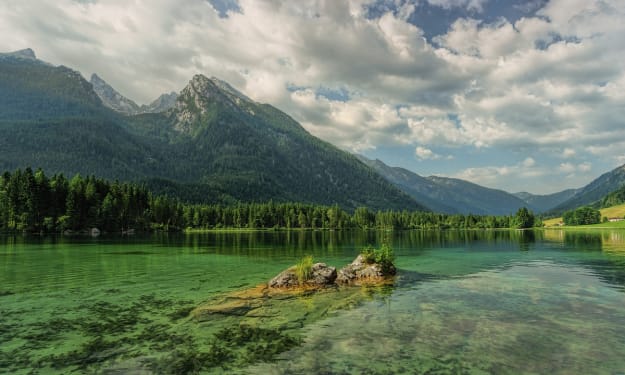
Unveiling the Mystery of Snowball Earth: Volcanoes and Weathering as Key Players
Exploring the Earth's Enigmatic Deep Freeze and the Birth of Complex Life
Introduction
The concept of Snowball Earth, a period when our planet was likely enveloped in ice caps and glaciers, has fascinated scientists for years. This intriguing phenomenon, which may have occurred several times in Earth's history, is characterized by glaciated fossils found in unexpected places, including tropical regions and areas near the equator. The most renowned Snowball Earth episode is believed to have started around 720 million years ago, during the so-called "boring billion" era, when life was in its primitive stages. This icy epoch lasted for approximately 60 million years before Earth gradually thawed, becoming more hospitable for multicellular life around 650 million years ago, during the Ediacaran Period. While the cause of this protracted glacial period had remained elusive for decades, recent geological evidence suggests a compelling explanation linked to a massive volcanic event.
The Franklin Large Igneous Province: A Key Player
Recent research has shed light on what could be the driving force behind the most famous Snowball Earth period. The culprit? Enormous volcanic eruptions, unlike any seen in Earth's history. These volcanic activities commenced approximately 720 million years ago and persisted for an astounding 2 million years. The epicentre of these volcanic eruptions was the Franklin Large Igneous Province, a vast region covering much of present-day North Canada. In this article, we delve into this groundbreaking discovery and its implications for understanding the Snowball Earth phenomenon.
Volcanoes: The Prime Suspects
Volcanoes have long been suspected as key players in causing drastic climate shifts, making them the prime suspects in the case of Snowball Earth. While other factors, such as the planet's position in the solar system or changes in solar emissions, have been suggested, they remain speculative without concrete evidence. Volcanoes, on the other hand, have a well-documented history of influencing Earth's climate, including their involvement in past extinction events.
A Prolonged Eruption on an Unprecedented Scale
What sets the Franklin Large Igneous Province apart is the continuous, colossal volcanic eruptions that spanned a vast expanse, stretching hundreds to thousands of kilometres. This relentless volcanic activity lasted for a staggering 2 million years, making it a unique geological phenomenon. The question then becomes: How could such eruptions lead to the radical climate shift that resulted in global glaciation?
Weathering: A Compelling Explanation
One of the most plausible explanations for the Snowball Earth event involves a geological process known as weathering. Weathering, a ubiquitous phenomenon on Earth, occurs when rainwater, containing trace amounts of acidity from carbon dioxide (CO2), reacts with minerals to form various salts and clays. This slow but efficient process is particularly potent when volcanic rocks, like those found in the Franklin Large Igneous Province, are involved. These rocks accelerate weathering, effectively serving as a CO2 sink, removing substantial amounts of this greenhouse gas from the atmosphere, and storing it in sediments. Over 2 million years and across a vast region, this relentless weathering process depleted the planet of its primary greenhouse gas, causing surface waters to freeze.
Why Weathering Makes Sense
The weathering explanation gains credibility due to the timeline involved. Unlike sulphur emissions, which act almost instantaneously and remain in the atmosphere for a short period, weathering is a gradual process that takes at least a million years to commence and several million years to significantly impact the climate. This extended timeline aligns with the onset of the Snowball Earth episode, making it a more plausible explanation.
A Global Phenomenon
Evidence of this dramatic glaciation event extends across all continents, reaching even to the equatorial regions. During this period, Earth likely consisted of a single supercontinent called Rodina, characterized by abundant rainfall and rapid weathering. The onset of weathering would have quickly led to glaciation, occurring in less than 2 million years, and lasting for nearly 60 million years. However, the mechanisms responsible for the eventual thaw and transition to a warmer planet remain a subject of ongoing research.
Conclusion: Unravelling Earth's Remarkable Mysteries
The Snowball Earth hypothesis has unveiled one of the most extraordinary events in Earth's history, a period that likely played a crucial role in the emergence of complex life. While it was not the first such glaciation event on our planet and may not be the last, it stands as a remarkable mystery worth exploring. As researchers continue to investigate the intriguing interplay of volcanic activity, weathering, and climate change during this enigmatic era, we inch closer to comprehending the forces that have shaped the Earth we know today.
About the Creator
Kyle Red
I am a passionate explorer of the fascinating interplay between biology, behavior, and well-being. With a keen interest the financial landscape, I delves deep into the science behind motivation, health, and success!





Comments
There are no comments for this story
Be the first to respond and start the conversation.